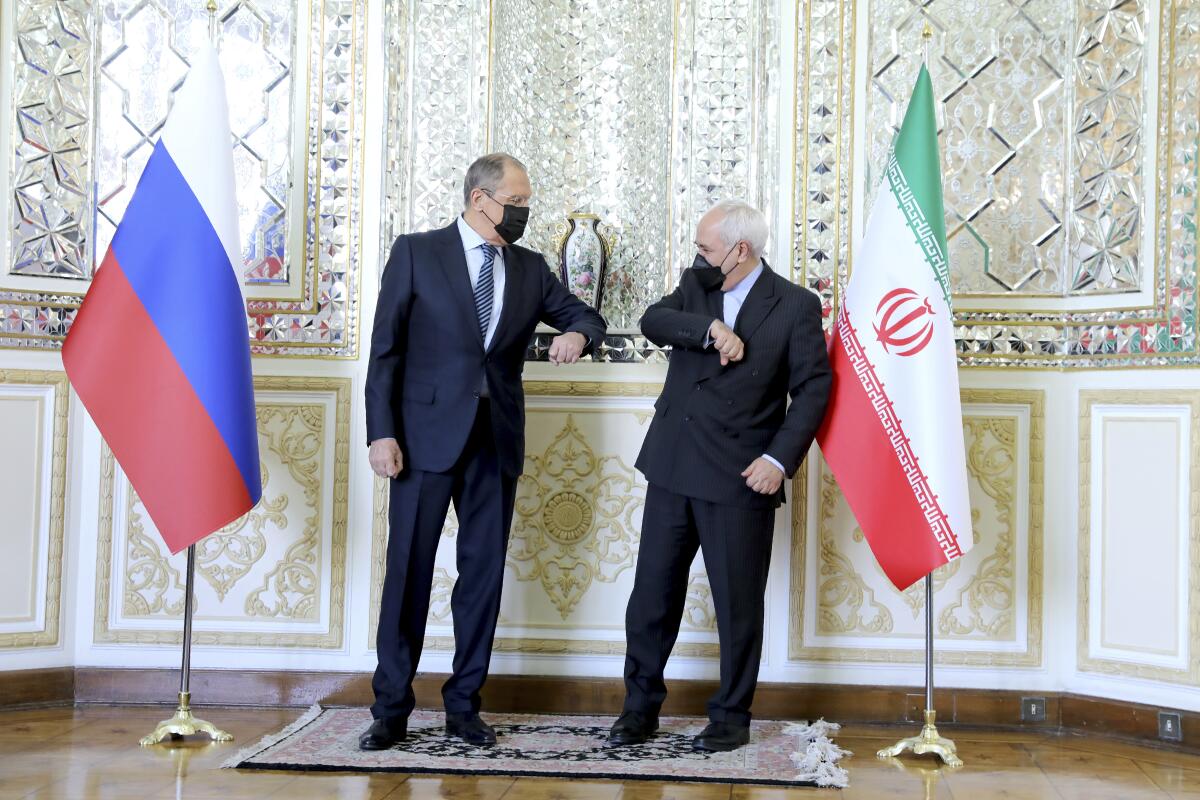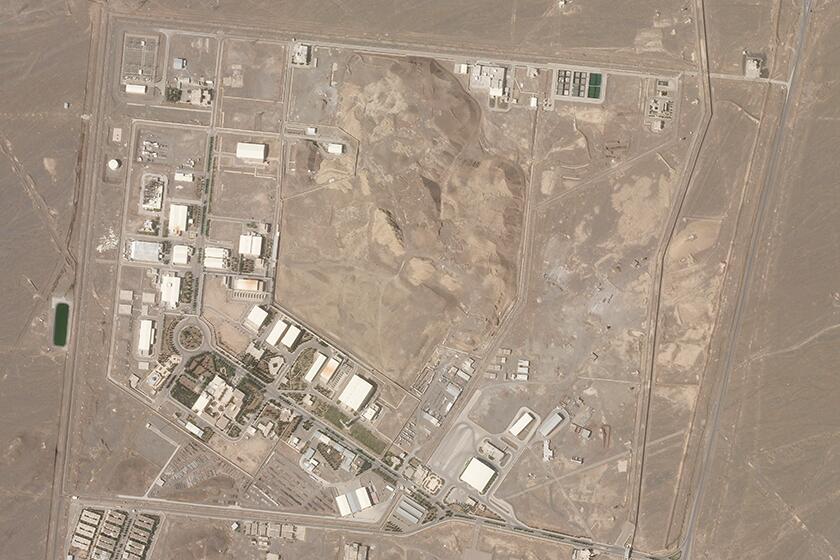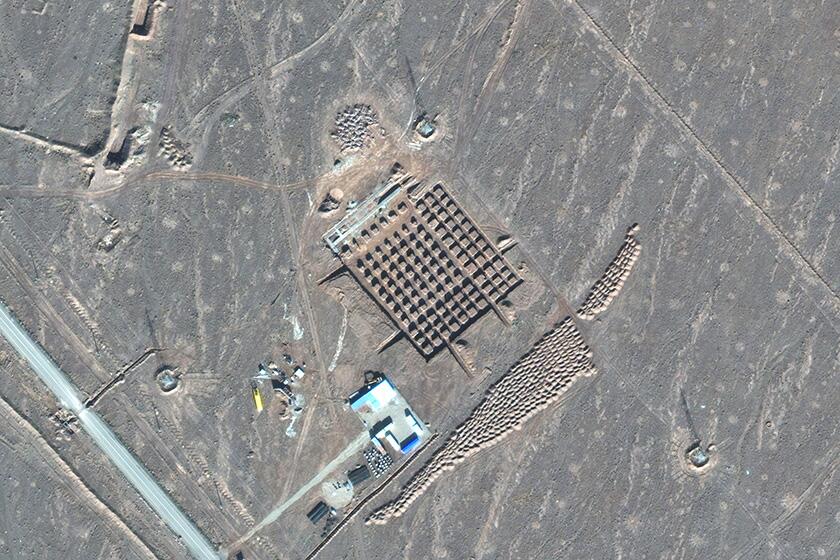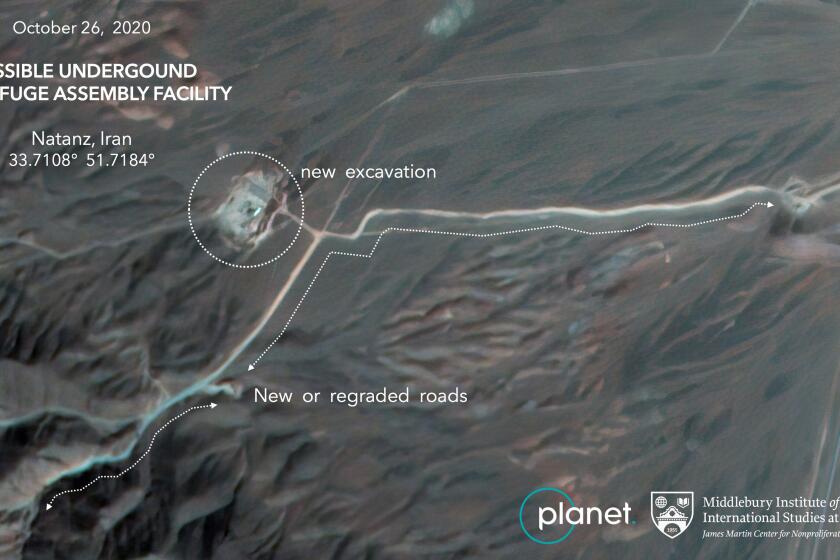Iran says it will enrich uranium to 60% in response to attack on nuclear facility

- Share via
DUBAI, United Arab Emirates — Iran will begin enriching uranium to 60% purity, higher than the program ever has before though still short of weapons-grade, after an attack on its Natanz nuclear facility, an Iranian negotiator said Tuesday.
The announcement marks a significant escalation after the sabotage, which Iran has blamed on Israel. It could result in further action by Israel, whose leader, Prime Minister Benjamin Netanyahu, has vowed never to allow Tehran to obtain a nuclear weapon, and further raise tensions across the Mideast.
Already earlier in the day, Iran’s foreign minister had warned that the weekend assault on Natanz could hurt ongoing negotiations over Tehran’s tattered atomic deal with world powers. Those talks are aimed at finding a way for the United States to reenter the agreement, the goal of which is to limit Iran’s uranium enrichment in exchange for sanctions relief.
“We believe that this round of negotiations is the time for the U.S. to present a list. I hope that I can go back to Tehran with the list of sanctions that will be lifted,” nuclear negotiator Abbas Araghchi said in Vienna, where the talks have been taking place. “Otherwise, I don’t believe we can continue like this. Otherwise, I believe this would be a waste of time.”
Araghchi said informal talks would start Tuesday night, with a formal session beginning Thursday.
Iran had been enriching uranium up to 20% — which is itself only a short technical step to weapons-grade enrichment of 90%.
‘Shadow’ conflict takes to the spotlight as Iran accuses Israel of attacking key nuclear site
The International Atomic Energy Agency said it was aware of media reports of Araghchi’s comment, which was quoted by Iran’s state-run IRNA news agency. But the IAEA did not comment further.
Press TV, the Iranian state television’s English-language arm, separately said that the IAEA had been informed of the move. It said the enrichment would begin as of Wednesday.
The broadcaster also quoted Araghchi as saying Iran would introduce another 1,000 centrifuges used in the enrichment process at Natanz.
Iranian Supreme Leader Ayatollah Ali Khamenei had threatened to go to 60% enrichment in February if the country needed.
Iran has begun construction at its underground nuclear facility at Fordo amid tensions with the U.S. over its atomic program, satellite images show.
“We are determined to develop our nuclear capabilities in line with the needs of the country,” Khamenei said then, according to a transcript of his speech published by his website. “For this reason, Iran’s enrichment will not be limited to 20%, and we will take whatever action is necessary for the country.”
Iran previously had said it could use uranium enriched up to 60% for nuclear-powered ships. The Islamic Republic currently has no such ships in its navy.
Details remained scarce about the weekend attack at Natanz. The event was initially described only as a blackout in the electrical grid feeding above-ground workshops and underground enrichment halls — but later Iranian officials began referring to it as an attack.
The U.S. has insisted that it had nothing to do with Sunday’s sabotage. Instead, Israel is widely believed to have carried out the assault that damaged centrifuges. Israel has not claimed responsibility but also has not denied it.
President Biden’s dilemma on the Iran nuclear deal: Go slow and risk war, or move fast even if it means an imperfect pact that hurts his domestic agenda.
Iranian Foreign Minister Mohammad Javad Zarif nonetheless issued a warning to Washington.
“Americans should know that neither sanctions nor sabotage actions would provide them with an instrument for talks,” Zarif said in Tehran alongside visiting Russian Foreign Minister Sergei Lavrov. “They should know that these actions would only make the situation difficult for them.”
Zarif separately renewed his earlier warning to Israel over the sabotage, saying that if Iran determines that its archenemy was behind it, “then Israel will get its response and will see what a stupid thing it has done.”
Kayhan, a hard-line Tehran newspaper, urged Iran to “walk out of the Vienna talks, suspend all nuclear commitments, retaliate against Israel and identify and dismantle the domestic infiltration network behind the sabotage.”
Breaking News
Get breaking news, investigations, analysis and more signature journalism from the Los Angeles Times in your inbox.
You may occasionally receive promotional content from the Los Angeles Times.
“Despite evidence that shows the role of the U.S. as main instigator of nuclear sabotage against Iran, unfortunately some statesmen, by purging the U.S. of responsibility, [aid] Washington’s crimes against the people of Iran,” the paper said in Tuesday’s editions.
While Kayhan is a small-circulation newspaper, its editor in chief, Hossein Shariatmadari, was appointed by Khamenei and has been described as an advisor to him in the past.
Such a walkout remains unlikely as the administration of President Hassan Rouhani, whose main diplomatic achievement was the 2015 accord, hopes to get the U.S. to rejoin it and provide desperately needed sanctions relief. However, pressure does appear to be growing within Iran’s theocracy over how to respond to the attack.
The talks in Vienna — among Iran, world powers still in the deal and the U.S. — are aimed at reviving America’s role in the agreement that former President Trump abandoned and lifting the sanctions he imposed. Iran, in turn, would return to the limits set by the deal and dilute its growing stockpile of uranium, some of which has been enriched up to a short step away from weapons-grade levels.
Iran insists its nuclear program is peaceful, though the West and the IAEA say Tehran had an organized military nuclear program up until the end of 2003. The deal is supposed to prevent Iran from having enough of a uranium stockpile to be able to pursue a nuclear weapon.
More to Read
Sign up for Essential California
The most important California stories and recommendations in your inbox every morning.
You may occasionally receive promotional content from the Los Angeles Times.
















